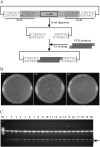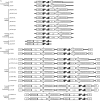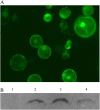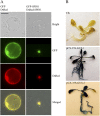A versatile zero background T-vector system for gene cloning and functional genomics
- PMID: 19403729
- PMCID: PMC2705043
- DOI: 10.1104/pp.109.137125
A versatile zero background T-vector system for gene cloning and functional genomics
Abstract
With the recent availability of complete genomic sequences of many organisms, high-throughput and cost-efficient systems for gene cloning and functional analysis are in great demand. Although site-specific recombination-based cloning systems, such as Gateway cloning technology, are extremely useful for efficient transfer of DNA fragments into multiple destination vectors, the two-step cloning process is time consuming and expensive. Here, we report a zero background TA cloning system that provides simple and high-efficiency direct cloning of PCR-amplified DNA fragments with almost no self-ligation. The improved T-vector system takes advantage of the restriction enzyme XcmI to generate a T-overhang after digestion and the negative selection marker gene ccdB to eliminate the self-ligation background after transformation. We demonstrate the feasibility and flexibility of the technology by developing a set of transient and stable transformation vectors for constitutive gene expression, gene silencing, protein tagging, protein subcellular localization detection, and promoter fragment activity analysis in plants. Because the system can be easily adapted for developing specialized expression vectors for other organisms, zero background TA provides a general, cost-efficient, and high-throughput platform that complements the Gateway cloning system for gene cloning and functional genomics.
Figures







Similar articles
-
A series of TA-based and zero-background vectors for plant functional genomics.PLoS One. 2013;8(3):e59576. doi: 10.1371/journal.pone.0059576. Epub 2013 Mar 29. PLoS One. 2013. PMID: 23555713 Free PMC article.
-
pXST, a novel vector for TA cloning and blunt-end cloning.BMC Biotechnol. 2018 Jul 13;18(1):44. doi: 10.1186/s12896-018-0456-8. BMC Biotechnol. 2018. PMID: 30005664 Free PMC article.
-
Positive-selection and ligation-independent cloning vectors for large scale in planta expression for plant functional genomics.Mol Cells. 2010 Dec;30(6):557-62. doi: 10.1007/s10059-010-0156-2. Epub 2010 Nov 26. Mol Cells. 2010. PMID: 21340673
-
High-throughput cloning and expression library creation for functional proteomics.Proteomics. 2013 May;13(9):1381-99. doi: 10.1002/pmic.201200456. Epub 2013 Apr 5. Proteomics. 2013. PMID: 23457047 Free PMC article. Review.
-
Direct cloning strategies for large genomic fragments: A review.Biotechnol Adv. 2025 Mar-Apr;79:108494. doi: 10.1016/j.biotechadv.2024.108494. Epub 2024 Dec 6. Biotechnol Adv. 2025. PMID: 39637950 Review.
Cited by
-
Nuclear progestin receptor (pgr) knockouts in zebrafish demonstrate role for pgr in ovulation but not in rapid non-genomic steroid mediated meiosis resumption.Front Endocrinol (Lausanne). 2015 Mar 19;6:37. doi: 10.3389/fendo.2015.00037. eCollection 2015. Front Endocrinol (Lausanne). 2015. PMID: 25852646 Free PMC article.
-
AaMYB3 interacts with AabHLH1 to regulate proanthocyanidin accumulation in Anthurium andraeanum (Hort.)-another strategy to modulate pigmentation.Hortic Res. 2019 Jan 1;6:14. doi: 10.1038/s41438-018-0102-6. eCollection 2019. Hortic Res. 2019. PMID: 30603098 Free PMC article.
-
MISSA is a highly efficient in vivo DNA assembly method for plant multiple-gene transformation.Plant Physiol. 2010 May;153(1):41-51. doi: 10.1104/pp.109.152249. Epub 2010 Mar 3. Plant Physiol. 2010. PMID: 20200068 Free PMC article.
-
Mitogen-activated protein kinase 14-mediated phosphorylation of MaMYB4 negatively regulates banana fruit ripening.Hortic Res. 2022 Oct 26;10(1):uhac243. doi: 10.1093/hr/uhac243. eCollection 2023. Hortic Res. 2022. PMID: 36643754 Free PMC article.
-
Molecular barcoding of viral vectors enables mapping and optimization of mRNA trans-splicing.RNA. 2018 May;24(5):673-687. doi: 10.1261/rna.063925.117. Epub 2018 Jan 31. RNA. 2018. PMID: 29386333 Free PMC article.
References
-
- Bernard P, Couturier M (1992) Cell killing by the F plasmid CcdB protein involves poisoning of DNA-topoisomerase II complexes. J Mol Biol 226 735–745 - PubMed
-
- Chen QJ, Zhou HM, Chen J, Wang XC (2006. a) Using a modified TA cloning method to create entry clones. Anal Biochem 358 120–125 - PubMed
-
- Chen S, Tao L, Zeng L, Vega-Sanchez ME, Umemura K, Wang GL (2006. b) A highly efficient transient protoplast system for analyzing defence gene expression and protein-protein interactions in rice. Mol Plant Pathol 7 417–427 - PubMed
-
- Christensen AH, Sharrock RA, Quail PH (1992) Maize polyubiquitin genes: structure, thermal perturbation of expression and transcript splicing, and promoter activity following transfer to protoplasts by electroporation. Plant Mol Biol 18 675–689 - PubMed
-
- Clough SJ, Bent AF (1998) Floral dip: a simplified method for Agrobacterium-mediated transformation of Arabidopsis thaliana. Plant J 16 735–743 - PubMed
Publication types
MeSH terms
Substances
Associated data
- Actions
- Actions
- Actions
- Actions
- Actions
- Actions
- Actions
- Actions
- Actions
- Actions
- Actions
- Actions
- Actions
- Actions
- Actions
- Actions
- Actions
- Actions
- Actions
- Actions
- Actions
- Actions
- Actions
- Actions
LinkOut - more resources
Full Text Sources

